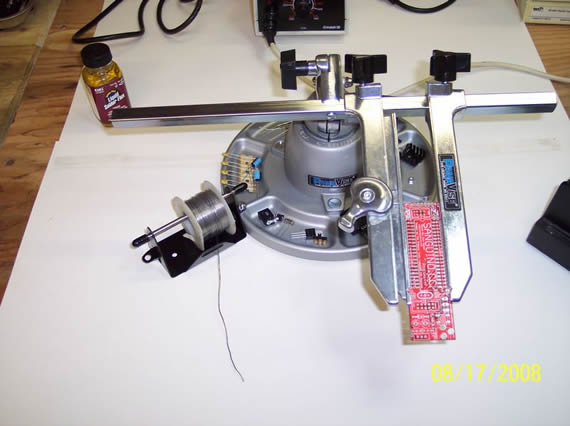This is a record of my assembly of the new Sanguino microcontroller board inspired by the Arduino project, specifically the Boarduino version. The sanguino is essentially the big brother to the Arduino and Boarduino (see comparision link). This new board design is the brain child of Zach Hoeken of NY and is distributed through RepRap Research Foundation store.
All the parts are accounted for except I got a straight serial header instead of a 90 degree as the docs indicate.

I have the Sanguino in my board vise and all the parts in the vise tray sorted by type. I’m read to go. G33KING out as you can see :)

To guarantee that the board pin headers are installed straight I just put them into my breadboard first.

Then I soldered the board in place. The rest of the solder work can be done in the board vise.

Adding 10k resistor

And we’re off

Soldering in the 40-pin DIP socket

Adding the two 33pF capacitors

Now for the diod, two LEDs, 16mhz crystal, two 1k resistors and the reset button.

I used lots of liquid solder flux during the assembly to get nice clean joints. This will clean up easily later.

Now for the final parts: just a few more capacitors, headers, power switch, power jack and a 7805 voltage regulator.

Clean up all that messy flux with 99.953% Isopropyl Alcohol and let dry.

Just to be safe I’m adding the heat sink using some thermal paste.

Make sure to bend the leads in a lot using a flat table top so the chip will pop into the 40-pin DIP socket without damaging the leads. Normally I use both hands to carefully bend the leads in but here I am holding the camera with my right hand.

Now insert the awesome Atmel ATmega644p microcontroller chip! (KICK ASS CHIP!!!)
You will need to be very careful when inserting the chip. Look at each pin as you press evenly all around the chips edges. If you see a pin that is going in wrong just backup, straighten it and try again. Also, chips can be put in too high or too low in the socket causing some pins not to connect with the socket connections or be very close to being an open.

Set the power switch to external and plug in a 9vdc wall wart. IT’S ALIVE… (evil laugh)
The circuit to the left of the Sanguino is a different project.

I kind of messed up with my first sketch thinking that the onboard red LED was connected to digital out 13 like on the Arduino. Being I did not see the red onboard debug LED flashing after loading my first sketch I though maybe my chip was bad or my LED was not soldered in correctly. I setup a 5v supply for testing the red debug LED in the circuit.

I took out the chip and connected the 5v from pin 1 to ground and as you see the red debug LED and wiring are just fine. Of course this is when I realized I was working with an all new form factor of the Arduino and needed to adjust my sketches accordantly. I knew this all along, but I was just so excited to see it running I skipped that step.

I then put the chip back in and successfully loaded several “updated” sketches without a problem. All worked just fine. Here you see the infamous BLINK sketch to the right of the Sanguino board (red LED on the breadboard). The circuit to the left of the Sanguino is a different project. Tomorrow I’m connecting servos BABY! (Bigger evil laugh…)


